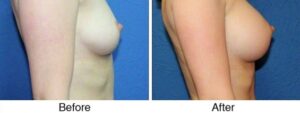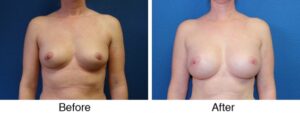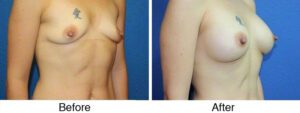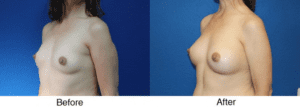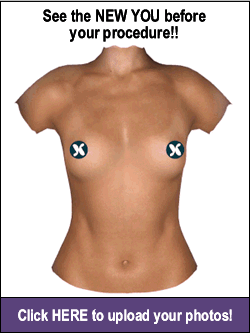What type of restrictions should I expect after surgery?
- No lifting/pushing/pulling anything over 10 lbs. for at least 4-6 weeks
- No bouncing or any strenuous activities with your upper extremities for at least 6 weeks
- No flexing of your chest muscles for at least 6 weeks
When can I go back to exercising after my breast augmentation?
Dr. Mayberry does recommend that you start with light walking immediately after surgery. No flexing of your chest muscles, weight lifting, or chest presses for at least six weeks (for both above the muscle and below the muscle placement).
What is the difference between saline implants and silicone implants?
- Saline implants are filled with sterile water. They are inserted empty and then filled once they are in place. Saline implants are less expensive than silicone implants. Saline implants allow for variability in filling range.
- Silicone implants are gel filled implants that come pre-filled by the manufacturer. Silicone implants offer more of a natural and softer feel that is more similar to natural breast tissue. Silicone implants are available to women 22 years and older.
What are the advantages of placing the implant above the muscle or below the muscle?
- When an implant is placed under the muscle, it applies some pressure on the implant and helps achieve the sloped look to the upper pole of the breast. Under the muscle placement of the implant is recommended for thin women or those with very little breast tissue. Under the muscle gives you that natural shape of a breast. When the pectoralis muscle is flexed the implant may create an animation effect. This animation resolves when the muscle is relaxed. Placing the implant under the muscle is recommended by the American Society of Plastic Surgeons.
- When an implant is placed on top of the muscle, they tend to look like the round shape of the implants. One of the advantages of placing the implant is that the shape of the breast will not be affected as the chest muscles contract.
What options are available for the placement of the incisions?
- Periareolar Incision - The incision is made around the areola.
- Transaxillary Incision - The implants are placed through an armpit incision with an endoscopic technique.
- Inframammary Crease Incision -The incision is made along the bottom of the breast along the crease or fold of the breast. This incision site is recommended by the American Society of Plastic Surgeons.
Who is a candidate for a breast augmentation?
- The best candidate for a breast augmentation are women how have read all the information and fully understand what is involved in the surgery and its limitations.
- Women who have realistic expectations.
- Common reasons for a breast augmentation include: small breasts, asymmetrical breasts, changes in breast size or shape due to weight loss, drooping or sagging breasts after pregnancy and breastfeeding.
Will pregnancy affect my breast augmentation?
Pregnancy does not effect the breast implants themselves, but it can effect the results of your breast augmentation. The stretching of your breasts during pregnancy and breast feeding may or may not cause changes that may require surgery in the future. You may or may not need larger implants or a breast lift.
What kind of bra should I wear after my breast augmentation?
After surgery you will go home in a post surgical bra that is included in your surgical quote. The surgical bra you will wear for about four to six weeks. The surgical bra allows your breasts to settle naturally with just enough compression and support. After the four to six weeks you will be able to go back to wearing a standard bra, but you cannot wear a bra with underwire at least six months after the surgery.
What type of anesthesia is used for a breast augmentation?
You will be under general anesthesia for approximately 60 minutes. The surgery is done in an ambulatory surgery center. It is a same day surgery, so once you are fully alert, awake, and walking you will be discharged home.
Will my nipple sensitivity be affected by a breast augmentation?
The risk of permanent sensation loss is low, it is possible to have alterations with your nipple sensitivity. The larger the implants the higher the risk of permanently altering your nipple sensation.

